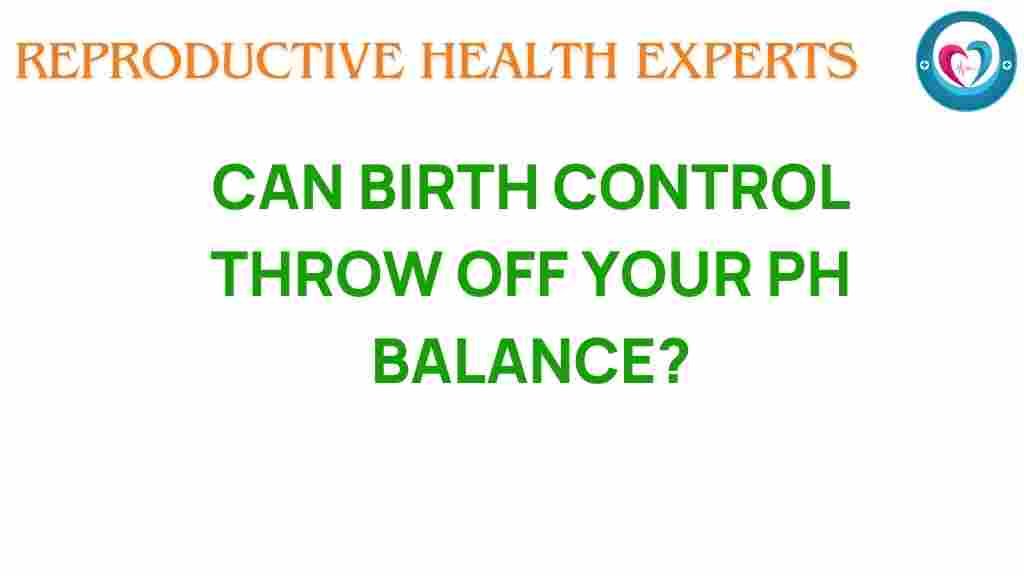Can Birth Control Disrupt Your pH Balance?
When it comes to women’s health, the topic of birth control is often surrounded by questions and concerns. One of the critical aspects that many women overlook is the relationship between birth control and pH balance. Understanding how contraceptives can influence pH levels is essential for maintaining optimal gynecological health. In this article, we will delve into how hormonal changes induced by birth control can disrupt your pH balance and what this means for your overall health.
Understanding pH Balance in Women’s Health
The pH scale measures how acidic or alkaline a solution is, ranging from 0 to 14. A pH of 7 is considered neutral, while values below 7 indicate acidity, and values above 7 indicate alkalinity. In the context of vaginal health, a normal pH range is between 3.8 and 4.5, which is slightly acidic. This acidity helps protect against infections and maintains a healthy balance of bacteria, particularly lactobacilli.
Maintaining this delicate balance is crucial for various aspects of women’s health, including:
- Preventing infections
- Regulating the menstrual cycle
- Promoting overall vaginal health
The Role of Birth Control in Hormonal Changes
Birth control methods, particularly hormonal contraceptives, work by altering the body’s natural hormonal balance. These methods include:
- Oral contraceptives (the pill)
- Hormonal IUDs
- Implants
- Injections
- Patches
The primary hormones involved in these contraceptives are estrogen and progesterone. When women use birth control, these hormones can lead to significant changes in the menstrual cycle and overall hormonal balance.
How Birth Control Affects pH Balance
The hormonal changes induced by birth control can lead to alterations in the vaginal environment, potentially affecting the pH balance. Here’s how:
- Increased Estrogen Levels: Many hormonal contraceptives increase estrogen levels, which can lead to increased glycogen production in vaginal tissues. This glycogen is then fermented by bacteria, potentially leading to a more acidic environment.
- Altered Bacterial Flora: Hormonal changes can disrupt the balance of good bacteria, such as Lactobacillus, which are crucial for maintaining a healthy pH. An imbalance may lead to conditions like bacterial vaginosis or yeast infections.
- Changes in Vaginal Secretions: Birth control can change the amount and consistency of vaginal secretions, which can influence pH levels and overall vaginal health.
Identifying Side Effects of Birth Control on pH Balance
While birth control can offer numerous benefits, it also comes with potential side effects that can disrupt pH balance. Some common side effects include:
- Increased risk of yeast infections
- Bacterial vaginosis
- Unusual discharge
- Itching or irritation
If you notice any of these symptoms while using birth control, it is essential to consult with your healthcare provider. They can help determine whether your contraceptive method is contributing to these issues.
Step-by-Step Process to Maintain pH Balance While on Birth Control
If you are concerned about how birth control may be affecting your pH balance, follow these steps to help maintain a healthy vaginal environment:
- Consult Your Healthcare Provider: Before starting or changing your birth control method, discuss any concerns regarding pH balance and potential side effects with your doctor.
- Monitor Your Symptoms: Keep track of any changes in your vaginal health, including unusual discharge, odor, or discomfort.
- Practice Good Hygiene: Maintain good genital hygiene by washing with mild soap and water. Avoid douches and scented products that can disrupt the natural pH balance.
- Stay Hydrated: Drink plenty of water to help your body maintain optimal function, including the regulation of pH levels.
- Consider Probiotics: Including probiotics in your diet may help restore the natural balance of bacteria in your vagina. Look for yogurt or supplements containing Lactobacillus.
- Be Mindful of Your Menstrual Cycle: Pay attention to how your body responds to different phases of your cycle, especially when starting or stopping birth control.
Troubleshooting pH Balance Issues
If you suspect that your birth control is disrupting your pH balance, here are some troubleshooting tips:
- Switch Birth Control Methods: If you experience persistent issues, consult your doctor about switching to a non-hormonal method of contraception.
- Use pH-Balancing Products: Consider using vaginal gels or washes that are specifically designed to maintain pH balance.
- Dietary Adjustments: Incorporate foods that support vaginal health, such as fermented foods like kimchi, sauerkraut, and yogurt, which can help maintain a healthy microbiome.
- Regular Check-Ups: Schedule regular gynecological exams to monitor your vaginal health and discuss any changes with your healthcare provider.
Conclusion: Prioritizing Your Gynecological Health
Understanding the relationship between birth control and pH balance is essential for women’s health. While hormonal contraceptives can effectively prevent pregnancy, they may also lead to changes in pH balance, potentially impacting vaginal health. By being proactive and monitoring your symptoms, you can take steps to maintain a healthy balance.
If you’re seeking more information on maintaining your vaginal health while using birth control, check out this resource on women’s health. Remember, your health is paramount, and consulting with your healthcare provider is always a wise decision.
In conclusion, while birth control can disrupt your pH balance, understanding its effects and taking preventive measures can help you maintain optimal gynecological health and well-being.
This article is in the category Conditions and created by ReproductiveHealthExperts Team
